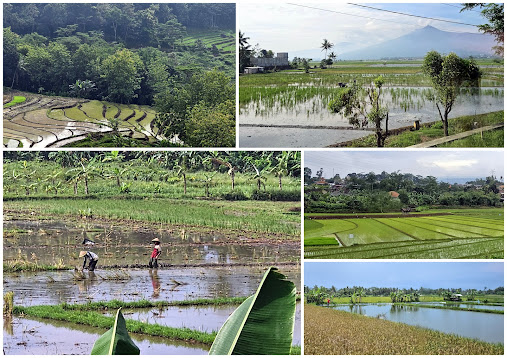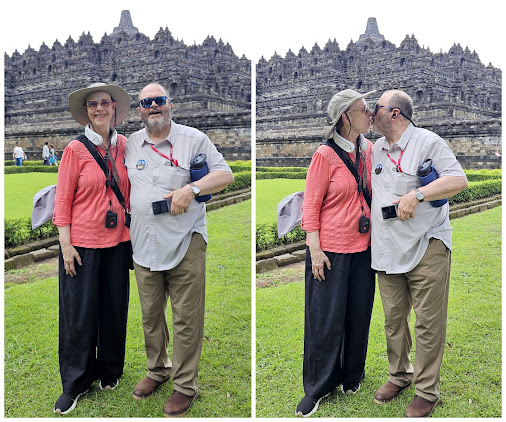Viking Sky arrived in Java, the most populous island in Indonesia, early this morning and docked at the port of Semarang. Java was an important trade center of the Dutch East India Company in the seventeenth and eighteenth centuries and is Indonesia’s repository of history and culture.
 |
| Sailing into Samarang |
Tim and I were off the ship by 7:30 am for a nine-hour optional excursion to see the world’s largest Buddhist temple. The excursion, “Borobudur Temple,” was described this way:
Behold an enormous 2,000-year-old terraced temple that rises, pyramid-like, amid emerald forests and fields. You will travel overland for about 3 hours through the “Garden of Java” to reach 9th-century Borobudur, a UNESCO World Heritage Site. The temple is remarkable not just for its beauty but for the symbolism of its design. Borobudur mimics the shape of a lotus and every aspect of it represents Buddhist views of the cosmos. There are six stacked square platforms topped by three circular ones, a central dome, and four stairways that lead to the top. Practically every square inch is covered with sculptural reliefs and there are 504 Buddha statues, making it a popular pilgrimage site. After exploring the temple, you will enjoy an included buffet lunch at the park’s Manohara Restaurant and then return to your ship.
Shortly after leaving Semarang, we began to climb one of Java’s many mountains, most of which are volcanic, and our guide informed us that Indonesia’s most active volcano, Merapi Volcano, had erupted last night, sending ash 7,000 feet into the sky. We didn’t see this volcano, but the views of the other mountains in the early morning mist were lovely, as were the many rice fields we passed.
 |
| The Mountains Around Semarang |
 |
| Rice Fields |
Traffic in Java is notoriously bad, so to complete our tour in nine hours, instead of twice that long, Viking arranged a police escort for our seven motorcoaches. What an unexpected thrill that turned out to be! Vehicles pulled over for us, we drove through red lights or in the opposite lane of traffic, and people often stared or waved. We almost felt like celebrities!
 |
| Our Police Escort |
We stopped for refreshments and a cup of delicious Java coffee before reaching Borobudur. The Dutch introduced coffee to Java in the eighteenth century, and Java coffee is now legendary. Most of Java’s coffee is grown on government-owned plantations.
 |
| Time for a Coffee Break |
Our first view of Borobudur, the largest Buddhist monument in the world, only hinted at its massive size. We were one of the first tour groups to climb the main steps, and for a few minutes, no one blocked our view. We could simply stare and try to grasp the size and intricate details on this structure.
 |
| Our First View of Borobudur |
 |
| The Massive Size of Borobudur is Hard to Believe |
According to Wikipedia, the monument consists of six square-shaped terraces on which there are three circular courts. The walls are decorated with 2,672 relief panels, the most complete and largest collection of Buddhist reliefs in the world. Originally, there were 504 Buddha statues. The largest central stupa (a dome-shaped structure serving as a Buddhist shrine) crowns the building and is surrounded by three circular rows of 72 perforated stupas in which a statue of Buddha sits cross-legged in a lotus position.
 |
| Incredible Details |
 |
| Thank Goodness for Zoom Lenses |
 |
| I Was Especially Impressed with the Relief Panels |
Borobudur is a model of the universe, and the devout walk up a clockwise path to the pinnacle. We were not able to climb the steps to make this pilgrimage since only the exterior is accessible on Mondays. Many Viking passengers had cancelled their tours when notified of this restriction, but I was perfectly content to view the temple from below.
Our guide walked us around Borobudur, explaining the symbolism of the relief panels and other elements, as well as many of the trees on the site. It was more information than I could process!
 |
| Our Excellent Guide Nurudin |
 |
| The Theme of Love Is Found on a Number of the Relief Panels, So Our Guide Requested Us to Kiss to Symbolize Our Love |
After one hour, we made our way down to street level and walked to the on-site restaurant for lunch. The threatening skies gave way to a downpour, but the rain had mostly stopped by the time we needed to reboard our bus for the drive back to our ship.
On the drive to and from Borobudur, I became interested in the architecture of Muslim religious structures. While Bali, which we visited a few days ago, is primarily Hindu, Java is 82 percent Muslim. We passed many very small buildings with what I would call onion domes on the roofs, as well as similar buildings that were somewhat larger. I only had a chance to ask our guide about them when we were getting off the bus at the port, and he told me they were prayer houses.
When I was putting this blog post together, I went down the proverbial rabbit hole to find out more about these structures. Google wasn’t much help since I wasn’t quite sure how to word a question. I finally turned to the experts – Viking crew members who are Muslim and from Indonesia, who kindly explained the differences and purposes to me.
The small buildings are known as musallas or musholas. These structures are prayer houses and are often found within households or neighborhoods. They are simple and functional and are specifically designed for daily prayers and small religious gatherings. Although those we passed were unpretentious, most incorporated a multi-tiered roof, which is characteristic of the vernacular Indonesian architectural style.
 |
| We Passed Many Musallas with Varying Designs |
The larger buildings I saw serve as places of worship and are called masjids or mosques. Most of these featured more orthodox architectural styles, incorporating minarets and domes with multi-colored geometric patterns, and the occasional menara or tower.
 |
| A Few of the Masjids or Mosques that We Passed |
I learned that the dome on top of a musalla or masjid is called a kubah. We even passed several shops alongside the highway where various types of kubahs were for sale.
 |
| There Are Many Types of Kubahs |
It was a very long day, but I thoroughly enjoyed the excursion, including the drive to and from Borobudur.

I look forward to reading every one of your posts. Today I actually learned something new so thank you for the detailed explanations. The pictures are wonderful and help me escape the cold of winter as I travel along with you on your travels. Your taking the time to journal and post is truly appreciated
ReplyDeleteThank you for the lovely comment. I'm happy to have you traveling with us.
Delete